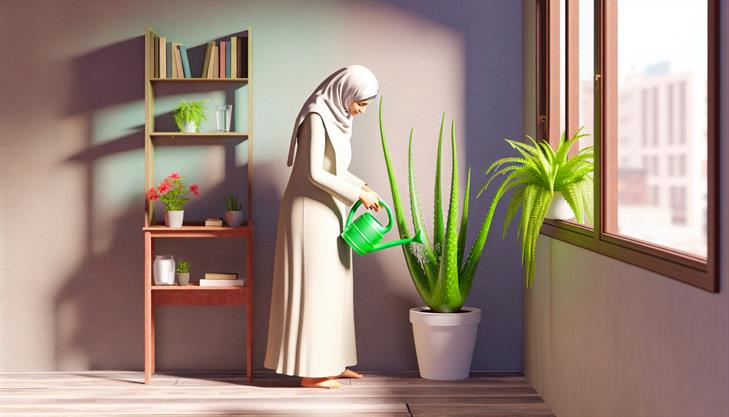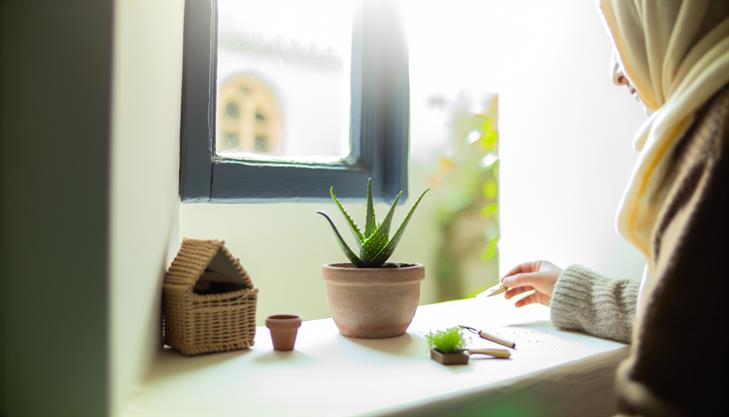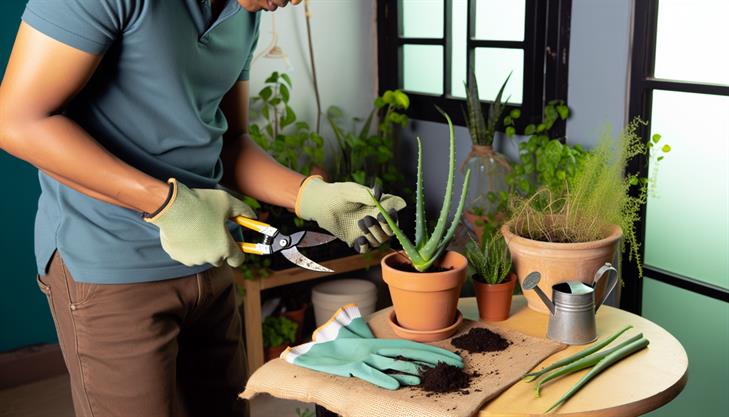Imagine walking through your living space, greeted by the vibrant green presence of an aloe plant—a living, breathing symbol of tranquility and nature’s healing powers. This humble houseplant does more than brighten up your home; it serves as a natural air purifier, a skin soother, and a boost to your indoor oasis. But as with any treasured companion, an aloe plant requires attention and understanding to truly thrive indoors. In our fast-paced lives, caring for a houseplant may feel like an overwhelming, meticulous task. However, unlocking the secret to maintaining a flourishing aloe plant is easier than you think, and the rewards of doing so are nothing short of remarkable. This guide will walk you through the essentials of aloe care, transforming you into a confident indoor horticulturist. From soil selection to sunlight needs, discover how simple and satisfying it can be to nurture this remarkable plant. Embark on this journey with us and bring the vitality and beauty of the aloe into every corner of your home.
Essential Tips for Growing Aloe Vera Inside Your Home
Caring for an aloe plant indoors is a rewarding endeavor that requires understanding its needs to thrive in a home environment. Aloe vera, known for its healing properties and air-purifying qualities, is a resilient succulent that becomes an attractive addition to any indoor garden. Here’s a comprehensive guide on how to care for an aloe plant indoors.
Suitable Location and Lighting
Aloe vera thrives in bright, indirect sunlight. To ensure your aloe plant grows well indoors, place it near a window that receives plenty of light, ideally a south or west-facing window. If natural light is insufficient, consider using a grow light to supplement. Insufficient light can lead to leggy growth as the plant stretches toward the light source.
Choosing the Right Pot and Soil
Selecting the right pot is essential for indoor aloe plant care. Use a container with drainage holes to prevent water from sitting at the bottom, which can lead to root rot. Terracotta pots are ideal as they are porous and allow the soil to dry more thoroughly between waterings.
For soil, utilize a well-draining cactus or succulent potting mix. You can also create your own mix by combining regular potting soil with sand or perlite to improve drainage.
Watering Your Aloe Vera
One of the most critical aspects of caring for an indoor aloe plant is mastering its watering needs. Aloe vera prefers to dry out completely between watering sessions. Water your plant thoroughly, ensuring water drains out of the bottom, then allow the soil to dry out entirely before watering again. Overwatering is a common issue and can lead to root rot.
Ideal Temperature and Humidity
Aloe vera is well-suited for typical indoor temperatures ranging from 55°F to 80°F (13°C to 27°C). Ensure it’s not exposed to freezing temperatures or drafts. Humidity is generally not a concern for aloe, as it prefers drier conditions, similar to its native desert environment.
Fertilizing Aloe Vera
Though aloe vera plants don’t require frequent feeding, you can promote healthy growth by using a diluted, balanced fertilizer once in the spring and again in the summer. Avoid over-fertilizing, as this can cause more harm than good.
Common Issues and Tips
- Leaf Tips Turning Brown: This often indicates underwatering or low humidity. Adjust watering frequency and check humidity levels.
- Soggy or Drooping Leaves: This problem is typical of overwatering or poor drainage. Ensure your pot has sufficient drainage, and allow the soil to dry out completely before the next watering.
- Pests: Aloe plants are generally pest-resistant, but they can occasionally attract mealybugs or aphids. Use insecticidal soap or neem oil to treat infestations.
With the right care, your indoor aloe plant will not only thrive but also serve as a beautiful and beneficial component of your home. By closely monitoring its light, water, and soil needs while addressing any common issues promptly, you’ll enjoy the natural elegance and health benefits aloe brings indoors.
Step-by-Step Guide to Watering and Lighting
Caring for an aloe plant indoors is relatively straightforward, but it requires attention to specific details to ensure your plant thrives. Below is a simple step-by-step guide to maintaining optimal watering and lighting conditions, along with tips on preventing common issues that might arise.
Watering Your Aloe Plant
-
Understand the Aloe’s Water Needs
Aloe vera is a succulent, meaning it stores water in its leaves. This characteristic makes it highly drought-resistant but also prone to overwatering if not managed properly. -
Watering Frequency
Allow the soil to dry out completely between waterings. A general rule of thumb is to water your aloe plant every two to three weeks in the spring and summer, reducing the frequency even more in the winter months when the plant is dormant. -
Proper Watering Technique
When watering, do so thoroughly until water drains from the pot. Ensure your pot has a drainage hole to prevent water from stagnating at the bottom, which can cause root rot. -
Signs of Overwatering or Underwatering
If you notice the leaves of your aloe plant turning yellow or becoming mushy, it might be overwatered. Conversely, if the leaves appear shriveled, your plant could be underwatered.
Lighting Requirements for Aloe Vera
-
Optimal Light Conditions
Aloe plants prefer bright, indirect light. Place your plant near a south- or west-facing window to receive plenty of sunlight while avoiding direct sun that can scorch the leaves. -
Supplemental Lighting
If adequate natural light is not available, particularly during the winter months, consider using a grow light to provide your aloe with the necessary light exposure. -
Rotation for Even Growth
Rotate the plant occasionally to ensure even light distribution and prevent it from leaning towards the light source.
Additional Tips for Aloe Plant Care
-
Soil Selection
Use a well-draining potting mix, ideally one designed for cacti and succulents, to further prevent root rot. -
Handling Temperature and Humidity
Aloe plants thrive in environments with temperatures between 60°F and 80°F and do not require high humidity levels. -
Common Pests
Keep an eye out for common pests like mealybugs or aphids. You can remove these manually or with a gentle spray of diluted dish soap. -
Repotting
Repot your aloe plant once it outgrows its container or if you notice the soil doesn’t dry out as well, which could indicate compacted roots. Typically, this might be necessary every couple of years.
By following these guidelines on how to care for an aloe plant indoors, you can enjoy a healthy, thriving plant that adds a touch of greenery and natural beauty to your home. Remember, consistency is key, and small adjustments in light and water can make a significant difference in your aloe plant’s overall health.
Optimizing Soil and Potting for Healthy Growth
Caring for an indoor aloe plant can be a rewarding experience, offering not only a touch of greenery to your space but also the practical benefits of its healing properties. To ensure your aloe plant thrives indoors, it is crucial to focus on a few essential aspects: potting, watering, lighting, and troubleshooting common issues.
Choosing the Right Pot and Soil
To begin with, select a pot with adequate drainage holes, as aloe plants are susceptible to root rot if water accumulates. A terracotta pot is ideal because it allows excess moisture to evaporate. When it comes to soil, opt for a well-draining mix; a commercial cactus or succulent soil will work well, or you can create your own by combining equal parts potting soil, sand, and perlite. This type of soil mix mimics the aloe plant’s natural arid habitat, encouraging healthy growth.
Optimal Watering Techniques
One of the most critical elements in how to care for an aloe plant indoors is mastering the art of watering. Aloe plants are drought-tolerant and prefer to dry out completely between waterings. Begin by checking the top 1-2 inches of soil; if it feels dry to the touch, it’s time to water. Water thoroughly, ensuring it drains out from the bottom of the pot, but be sure not to let the plant sit in standing water. Overwatering is a common mistake that can lead to root rot, so always err on the side of underwatering.
Lighting Requirements
Proper lighting is essential for the indoor care of aloe plants. Place your aloe in a spot where it can receive bright, indirect sunlight. A south- or west-facing window is ideal. Direct sunlight through glass can be too intense and may scorch the leaves. If you notice your aloe is stretching or becoming leggy, it may not be receiving enough light. In such cases, consider supplementing with artificial grow lights to provide additional support.
Addressing Common Problems
Indoor aloe plants can sometimes face issues such as pests or diseases. Mealybugs are a common pest; they can be treated by swabbing affected areas with a cotton ball dipped in rubbing alcohol. Additionally, if your aloe plant’s leaves appear soft or mushy, this might indicate overwatering. Make sure to adjust your watering schedule accordingly and check that your pot has proper drainage.
Additional Tips for Healthy Growth
To further promote healthy growth, consider rotating your plant periodically to ensure even exposure to light. Feeding your aloe with a diluted liquid fertilizer during the active growing season, typically from spring to early autumn, can boost its nutrients. However, aloe plants generally do not require frequent fertilization, so once or twice a year is sufficient.
Taking these steps to optimize your soil and potting conditions, alongside careful attention to watering and lighting, will create an ideal environment for your aloe plant’s indoor success. With patience and care, you’ll enjoy a healthy, thriving aloe plant that enhances your indoor space.
Effective Techniques for Pruning and Repotting
Caring for an aloe plant indoors can be rewarding, as these resilient succulents are known for their air-purifying properties and medicinal benefits. If you’re looking for guidance on how to care for aloe plant indoors, follow these comprehensive and easy-to-follow tips to keep your aloe healthy and thriving.
1. Choosing the Right Container and Soil:
- Select a Suitable Pot: Use a pot with drainage holes to prevent water from accumulating at the bottom. Terra cotta pots are ideal due to their porous nature, which helps in moisture control.
- Use Well-Draining Soil: Aloe plants prefer a cactus or succulent potting mix. You can create your own by mixing regular potting soil with sand or perlite to enhance drainage.
2. Positioning the Aloe Plant:
- Place in Bright, Indirect Light: Aloe plants need plenty of sunlight but should avoid direct sunlight that may scorch their leaves. A south or west-facing window is often a perfect spot.
- Rotate Periodically: To promote even growth, rotate your aloe plant every few weeks to ensure all sides receive adequate light.
3. Watering Guidelines:
- Water Sparingly: Allow the soil to dry out completely between waterings. Typically, watering every 3 weeks is sufficient for indoor aloe plants.
- Watch for Overwatering: Overwatering is a common issue leading to root rot. If the leaves start to turn brown or become mushy, reduce watering frequency.
4. Temperature and Humidity:
- Maintain Optimal Temperatures: Aloe vera thrives in temperatures between 55°F and 80°F (13°C to 27°C). Keep them away from cold drafts or sudden temperature changes.
- Average Home Humidity: Aloe plants are not too fussy about humidity and generally do well in average household conditions.
5. Pruning and Clean-Up:
- Remove Dead Leaves: Gently trim away any dead or damaged leaves to maintain the plant’s health. Use a clean, sharp knife or scissors to avoid infections.
- Check for Pests: Occasionally, check your aloe for pests like mealybugs. Wipe the leaves with a mixture of water and mild soap if necessary.
6. Repotting When Needed:
- Repot Every Couple of Years: If your aloe plant becomes root-bound or too large for its pot, repot it in a slightly larger container. Spring is the best time for repotting.
- Handle with Care: When repotting, handle the plant gently to avoid breaking the leaves and roots.
7. Fertilization:
- Minimal Fertilizer Needs: Aloe plants require light feeding. Use a half-strength, balanced houseplant fertilizer once during the spring and summer months.
8. Common Issues and Troubleshooting:
- Leaf Curling or Browning: This can occur due to insufficient light or overwatering. Adjust light exposure and ensure the soil is kept dry.
- Growth Stagnation: If your aloe plant isn’t growing, consider adjusting its position to a brighter spot or inspect the root system for rot.
By following these guidelines on how to care for aloe plant indoors, you can ensure a robust and vibrant plant that beautifies your home and offers its natural therapeutic benefits. Remember, patience and regular observation are key to healthy indoor aloe cultivation.
Troubleshooting Common Indoor Aloe Plant Issues.
Caring for an aloe plant indoors can be a fulfilling and relatively low-maintenance experience, provided you understand its basic needs. Aloe plants are succulents, known for their resilience and air-purifying properties. Here’s a comprehensive guide to help you ensure your indoor aloe plant thrives.
1. Select the Right Pot and Soil:
- Begin by choosing a pot with drainage holes. Aloe plants are susceptible to root rot if left in standing water, so a well-draining environment is essential.
- Use a cactus or succulent potting mix to provide excellent drainage. If unavailable, you can make your own by mixing regular potting soil with coarse sand or perlite to improve aeration and drainage.
2. Provide Adequate Lighting:
- Aloe plants require bright, indirect sunlight. Position your aloe near a south or west-facing window to ensure it receives plenty of light. If natural light is insufficient, consider using a grow light to supplement the lighting needs, especially in winter or gloomy conditions.
3. Watering Needs:
- Watering is a critical aspect of how to care for an aloe plant indoors. Water your aloe heavily but infrequently, allowing the soil to completely dry out between waterings. Overwatering is the most common issue, leading to root rot.
- A good rule of thumb is to water every 2-3 weeks. During spring and summer, when the plant is actively growing, you might need to water more often. In contrast, reduce watering in the fall and winter when growth slows down.
4. Temperature and Humidity:
- Aloe plants prefer temperatures between 60-75°F (15-24°C), similar to room temperature. They can tolerate slightly cooler conditions indoors in the winter but should not be exposed to freezing temperatures.
- Generally, indoor humidity levels are suitable for aloe plants. They thrive in dry conditions typical of most homes, so no additional humidity is necessary.
5. Fertilization:
- Feed your aloe plant with a diluted, balanced, water-soluble fertilizer once in the spring and again in the summer. Over-fertilizing can harm your plant, so avoid applying more than twice a year.
6. Common Issues and Solutions:
- Sunburn: If your aloe’s leaves become brown or red, it may be getting too much direct sunlight. Move it to a slightly shadier location.
- Wilting or Browning Leaves: Overwatering or poor drainage might be the cause. Check the soil’s moisture and adjust your watering schedule accordingly.
- Pest Infestations: Aloe plants can be affected by common pests like aphids or mealybugs. Treat infestations by wiping leaves with a mild insecticidal soap or neem oil solution.
7. Repotting:
- Repot your aloe plant every 2-3 years or when roots outgrow the container. This is typically done in spring, allowing the plant to recover as it enters the growing season. Use fresh soil and a slightly larger pot to accommodate growth.
By following these guidelines on how to care for an aloe plant indoors, you can cultivate a healthy, vibrant plant that not only enhances your living space but also provides a natural air purifier. Remember, the key to thriving indoor aloe lies in mimicking its natural habitat: bright, indirect sunlight, moderate watering, and excellent drainage.
In conclusion, caring for an aloe plant indoors is a rewarding endeavor that ensures the plant’s health and longevity while enhancing your living space with its natural beauty and air-purifying benefits. By providing your aloe with the right amount of sunlight, ensuring well-draining soil, being mindful of watering practices, and maintaining a suitable temperature and humidity level, you’ll set the stage for a thriving plant. Remember to occasionally fertilize and prune your aloe to encourage growth and prevent overcrowding. With patience and attention, your aloe plant can flourish indoors, bringing a touch of greenery and tranquility to your home.
As a final tip, consider rotating your aloe plant every couple of weeks. This practice promotes balanced growth by exposing different sides to sunlight, preventing the plant from leaning towards one direction. Apply these insights with enthusiasm, and watch your aloe plant thrive, reflecting your dedication and care.


